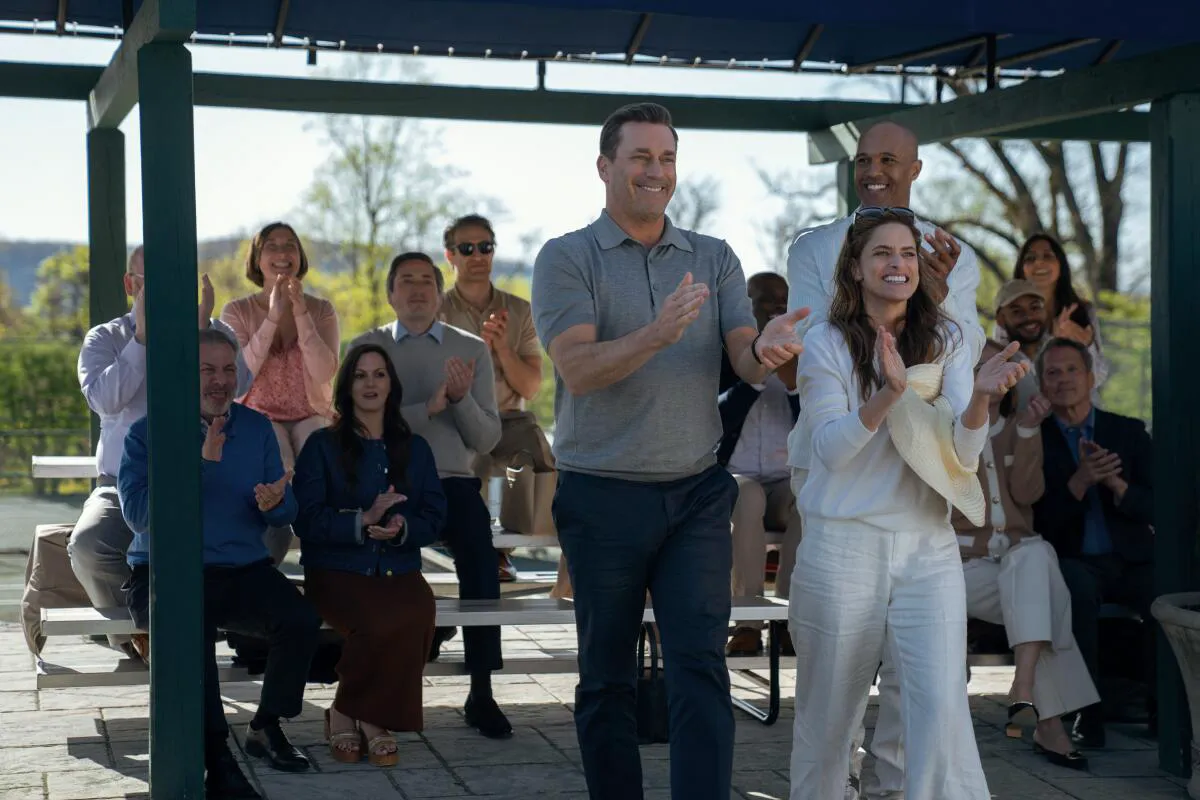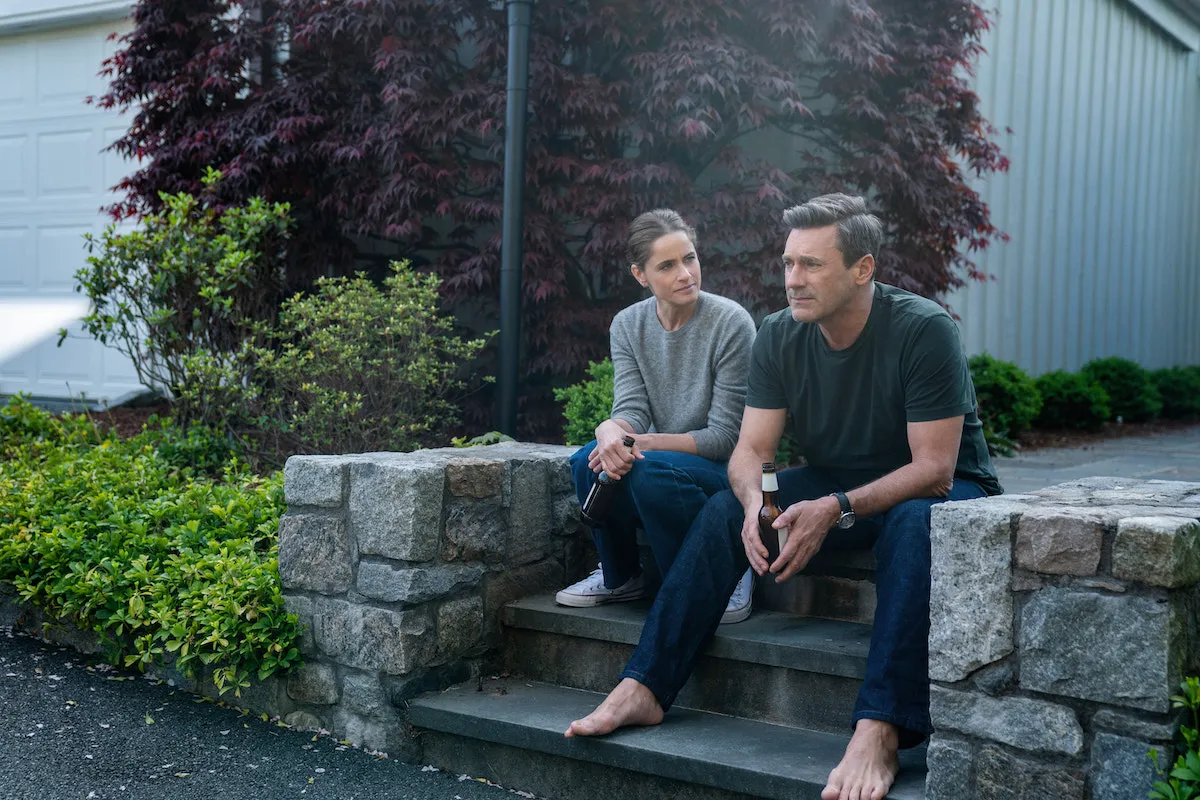Andrew, a successful hedge fund manager nicknamed “Coop” (Jon Hamm), has lost everything that mattered in life. First, his family – a couple of years ago, he came home at the wrong time and caught his wife (Amanda Peet) in bed with his best friend (Mark Tallman). Coop never forgave the betrayal but nobly moved out of their beautiful home so that his wife, her new boyfriend, and their teenage children could continue to live comfortably.
Now, Andrew has also lost his job – ostensibly for sleeping with a colleague, but in reality, due to the betrayal of a greedy business partner. He doesn’t want to announce the shameful dismissal, and the money for his luxurious lifestyle is evaporating by the minute. Experiencing all sorts of crises, from mid-life to existential, Coop finds a convenient, albeit temporary, solution to the problem: he starts pilfering expensive watches and wads of cash from his neighbors, who aren’t in the habit of locking their homes.

Jon Hamm as Andrew Cooper in a still from “Friends and Neighbors”
“Friends and Neighbors” is Apple TV+'s second major premiere this spring, and again, it’s more of a disappointment. The first, as you may recall, was the crime thriller “Narcowars” – about two friends who robbed drug dens while posing as DEA agents, but crossed a local crime boss and attracted the attention of the police. Both projects highlight a fundamental problem with modern TV series, which can’t be hidden by desperate attempts to “make it prestigious” – pouring in a huge budget, attracting talented creators, and casting prominent Hollywood actors in the lead roles. It’s not even about the stretched-out runtime, which streaming services use to keep subscribers glued to their screens. Plenty of scathing reviews have already been written about that.
A less obvious problem is the overly intriguing setup, designed to instantly grab the audience or effortlessly pitch the idea to management. Many modern series start with a striking or shocking event – a failed robbery, an unexpected act, or even a murder, which becomes the focal point for the drama. The world of the series exists in orbit around this incident. Characters and events are directly related to or dependent on the central intrigue. This is by no means a flaw – it’s simply that this model requires maintaining an extremely high level of intrigue and suspense throughout the entire runtime. Imagine a version of “Lost” in which the creators limited themselves to the plane crash and didn’t show flashbacks, the black smoke, the whispering “others,” or the mysterious radio signal.

Olivia Munn as Sam in a still from “Friends and Neighbors”
The Golden Age of TV Dramas
For comparison, the prestigious dramas of television’s golden age, which streaming shows love to emulate, were built around a setting, ambiguous characters, or a slice of a closed society. The creators trusted the viewer and slowly immersed them in a self-contained world in the early episodes: the criminal streets of Baltimore (“The Wire”), the organized crime of New Jersey (“The Sopranos”), a small settlement in the Wild West (“Deadwood”), and so on. For an equally successful example, one doesn’t have to look far – we learned about Jon Hamm thanks to a series whose synopsis still scares off potential viewers: the daily life of advertisers in the 1960s – in the office and beyond. It’s hard to remember now that the main revelation of the “Mad Men” pilot was that the creative genius with the playboy looks, who easily seduced clients, returned home at the end of the workday – to his wife and children.
The Show’s Shortcomings
Ironically, the creators of “Friends and Neighbors” aren’t content with a gripping premise – they create an additional layer of intrigue. In the first minutes of the pilot, we see Coop wake up in a pool of blood in someone else’s house, and while trying to escape, he’s spotted by someone and falls into a pool. Not only is this not the most original way to start a story, but the introduction is also presented clumsily and directly, with an obvious metaphor of sinking to the bottom and a voiceover in the style of meme phrases: “Yes, that’s me. You’re probably wondering how I got here…” The problem is that by the second episode, you forget about the shocking opening, and the plot about a rich man betraying and robbing the rich turns out to be a smokescreen for something safer and more predictable. To be more precise, a Ted Lasso-ified dramedy about trying to reboot and restore long-destroyed relationships with family. Perhaps there can never be too many emotionally comfortable series, but therapeutic plots don’t really mesh with eat-the-rich satire.

Amanda Peet as Mel Cooper in a still from “Friends and Neighbors”
The mockery in “Friends and Neighbors” is limited to primitive criticism of tactless and gluttonous millionaires. In one scene, Coop finds a collection of expensive jewelry in his neighbors’ house and delivers a monologue about excessive consumerism – the scourge of modernity, which is amplified a hundredfold among the rich. In another, Coop is surprised by the inhumane indifference of the elite and realizes that they only care about appearances – success, good relationships, or respectability. In reality, they are filled with envy, hatred for each other, and a cannibalistic desire to take the place of a more successful comrade. The creators don’t go any further than this – the thefts are limited to pocket change, and the secrets that Coop learns while breaking into homes can’t be called spicy. In one episode, the hero finds answers to exam questions, pre-purchased by parents for their high school daughter! 20 years ago, “Weeds,” in which a suburban housewife sold weed to her neighbors, told us much more about what lies behind the facade of American prosperity.